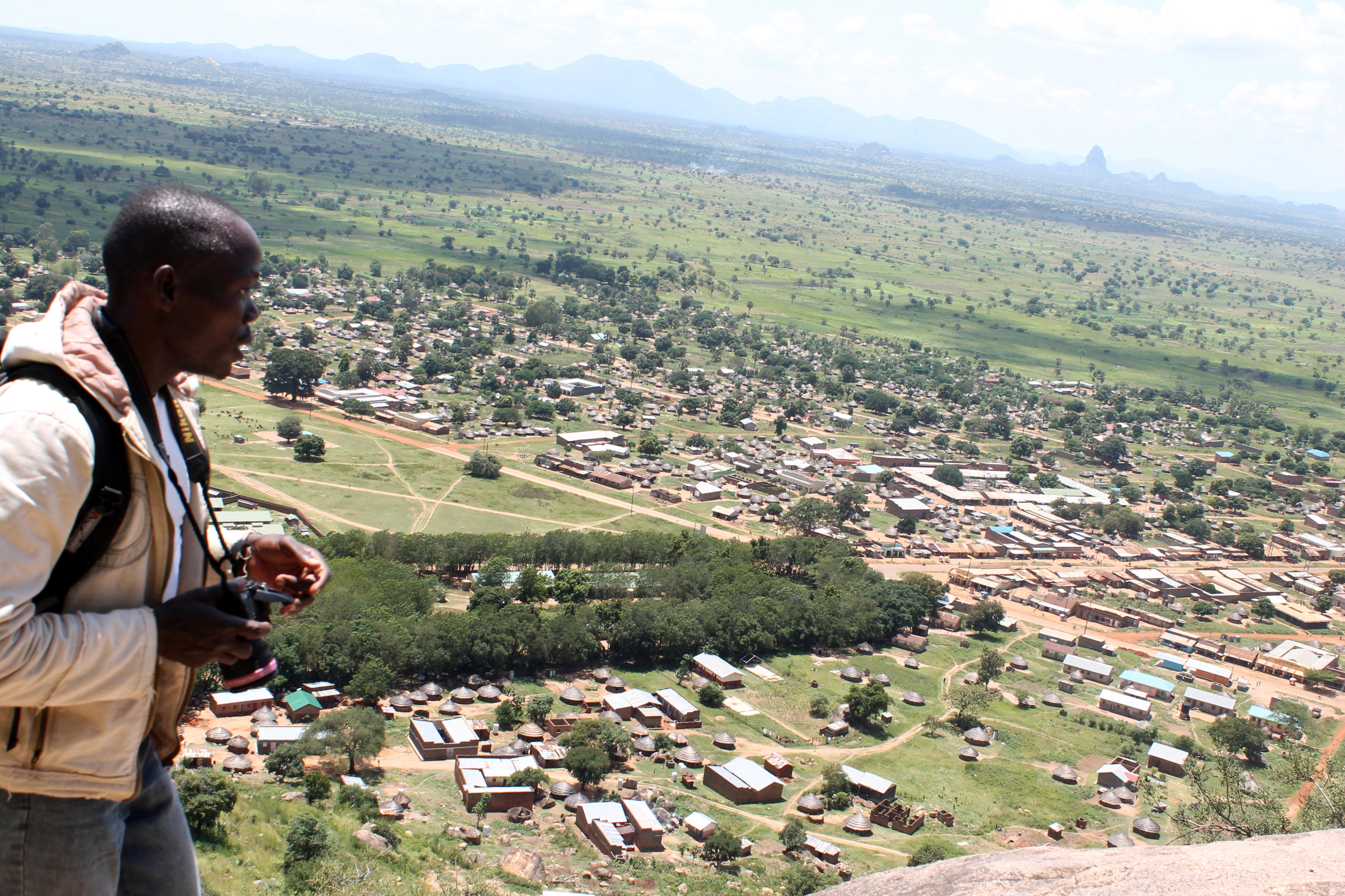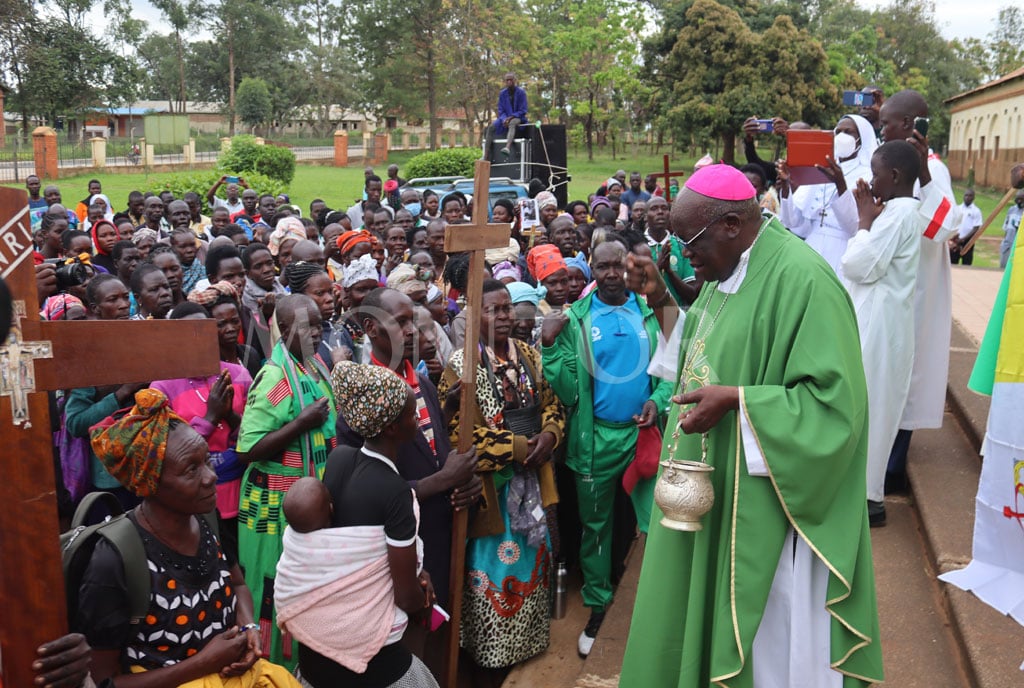Prime
Kalongo’s bitter history and the trail of ‘Saints’

An aerial view of Kalongo Town Council in Agago district. The area is home to Kalongo Catholic Mission, which administers Kalongo (Dr Ambrosoli Memorial) hospital in the same location. PHOTO | TOBBIAS JOLLY OWINY
What you need to know:
- Thousands of Catholic believers will gather in Kalongo today to attend the beatification of Fr Dr Joseph Ambrosoli, who is credited for transforming the area.
Perched precariously on the eastern edge of Kalongo Hills in Kalongo Town Council, Agago District, is a vast establishment of Kalongo Catholic Mission.
Besides Kalongo (Dr Ambrosoli Memorial) hospital, a 350-bed community hospital both administered by the Catholic Archdiocese of Gulu, sits St Mary’s School of Nursing and Midwifery, and the airstrip, privately administered by the hospital. Both the hospital and the airstrip squat at the foot of the 1,300ft Kalongo Rock.
Seventy years ago, the hospital operated as a medical clinic and a lepers’ village run by the Catholic Comboni Missionaries of Kalongo Catholic Mission. Lepers were isolated, treated and cared for at the small clinic before Fr Dr Joseph Ambrosoli, a Comboni Missionary priest, who headed the mission, embarked on transforming the facility into a fully-fledged hospital.
Today, at the top of Kalongo Hill sits a military detachment and a three-metre aluminium cross whose fluorescent tubes ensure there’s neon light by nightfall.
Desultorily, South of the hill is a stream whose unused water source remains a mystery. Mr Yoventino Owiny, a 98-year-old resident of Kokil Central village in Paimol Sub-county, has not forgotten the tale of how two Arabs and an elephant reportedly drowned in the stream in separate incidents.
The entire Kalongo area was a preferred settlement for the Arabs, who loved its weather and safety until the Comboni missionaries started traversing the area doing pastoral work.
“Conflict of interest between the Arabs and the missionaries forced the Arabs to leave Kalongo hills and relocate to Kokil and establish their base,” Mr Owiny recalls, adding that once a herd of three marauding elephants were swallowed by the same stream.
The Arabs initially entered the Kalongo area to trade ivory and slaves. Between 1915 and 1920, they were locked in a battle with the missionaries. Mr Owiny says while the Arabs enjoyed massive local support, Christianity wasn’t perceived well.
Young martyrs
In fact, two young Acholi Christians (Catechists)—Jildo Irwa (born around 1906 in Labongo-Amida in Kitgum District) and Daudi Okello (born around 1902 in Ogom, on the Gulu-Kitgum road)—were martyred few years after the missionaries founded the Kitgum mission in 1915. The pair was hounded, threatened and killed (by spearing) in October 1918 by a group of guards commissioned by Rwot Ogal, the then sub-chief of Paimol in present-day Agago District.
A separate book authored by the late Prof. J.J. Otim, whose father (Yosefu Ocaya) was among the first catechists to serve the missionaries in the 1920s, states that Irwa and Okello’s remains were abandoned in an open landscape at Palamuku between the cascaded hills of Paimol. Their remains, according to the Vatican website, were interred in anthills until 1926 when they were collected and taken to Kitgum.
“The mortal remains, collected in February 1926, were later placed in the mission church of Kitgum, at the foot of the altar of the Sacred Heart,” the website says.
Today, the field has been renamed Wii-Polo (heaven).
Before Irwa and Okello’s execution, Yosefu Ocaya, together with Genasio Labongo, traversed areas of Lira-palwo, Patongo and Lapono, together with Fr Cesare Gambaretto in search of a suitable location to establish the next mission after Kitgum.
The duo led Fr Gambaretto back to Kalongo on their way to Kitgum to have a break. Fr Gambaretto quickly fell in love with the area and recommended it for their settlement.
Prof Otim’s book says Ocaya and Labongo travelled with Fr Gambaretto to Wii-Polo to recover the remains of Irwa and Okello, and they brought them to Kitgum Mission. Pope John Paul II beatified the pair on October 20, 2002, because they provided medical treatment and education besides teaching religion.
“My late father’s narrative was that while the missionaries were hated by the local administration and the Arabs, in communities, locals celebrated them because they provided medical treatment, and education besides teaching religion,” Ms Sabina Atoo notes, adding that their charitable acts changed the narrative about them.
Ambrosoli influence
The missionaries taught religion and provided medical facilities—all in “grass-thatched units” as per Mr Owiny—to locals. At Fr Dr Joseph Gambaretto’s prompting, a permanent structure was put up for the church.
A Comboni Missionary document indicates that Fr Dr Ambrosoli was posted to the mission in February 1956 as a parish priest. This was purely on the basis that he was a medical doctor, who would help handle the high prevalence of tropical disease and leprosy.
As a little girl, Ms Atoo recalls “Dr Ambrosoli was greeted by the sight of a man mauled by a lion.” He would treat the victim “for about eight months.”
In 1957, he initiated the transformation of the clinic into a hospital and made sure lepers weren’t ostracised. Dr Ambrosoli then established Saint Mary’s School of Midwifery in 1959 to enable him to localise care for the lepers. Soon, lepers were pouring in from central Uganda, Kenya, Somalia, Sudan, among other areas.
The hospital’s operations were, however, momentarily interrupted in February 1987 when government forces (army) reportedly forced an evacuation of the hospital, its staff and patients to Lira. This was thanks to the Lord’s Resistance Army insurgency that raged in the area. The army also reportedly set fire to the remaining medical logistics and stores to stop the rebels from accessing them. Dr Ambrosoli had been given 24 hours to evacuate the hospital. It would return to Kalongo in 1989.
The nursing school attached to the hospital was momentarily forced to relocate to St Luke’s Hospital (Angal in Nebbi District) and only relocated to Kalongo in 1990.
On March 27, 1987, Dr Ambrosoli succumbed to a kidney (renal failure) disease. Today, his remains rest within the mission near the hospital that now bears his name.
Prof Ogenga Latigo, a former Agago North lawmaker, says “the hospital has been very significant in transforming the quality of healthcare in the region.” He believes without the church, public infrastructure in the area—such as the Kalongo-Wol, Kalongo-Patongo and Kalongo-Kitgum roads—would have largely remained abandoned.
Beatification
The hospital is now a 350-bed capacity facility and serves nearly 60,000 people every year. After two years of postponement due to the Covid-19 pandemic, the beatification of Fr Dr Ambrosoli will be celebrated today (November 20).
Pope Francis, on November 28, 2019, granted the publication of the decree on the miracle obtained through the intercession of Fr Dr Ambrosoli. He was famed as the “saint doctor” or “great doctor”, thanks to his compassion and loving care for the sick. It is believed he even inexplicably cured a Kalongo-based woman on October 25, 2008, eighteen years after his death.
Lucia Lomokol, then aged 20, lost her unborn baby and suffered sepsis or blood poisoning by bacteria after arriving at the hospital too late.
Her condition was so puzzling that one doctor reportedly placed on her pillow a card of Dr Ambrosoli and asked her relatives to pray to the “saint doctor.” The next morning, Ms Lomokol had recovered against all odds. Pope Francis declared the healing a miracle on November 29, 2019, a step that led to the sanctioning of his beatification.
“The doctors were sure that the woman would die. It was a deathbed case but when one of the doctors came back about 5am the next day in the morning to check and see how to dispose of her dead body, he found the woman alive, talking and looking around,” Archbishop John Baptist Odama, the Gulu Archdiocese head, recalls, adding, “The doctors sent a message to the priests and to the bishops of how the woman was unusually healed, records were written and sent to Rome with other testimonies. The church also brought in several doctors who examined the woman but said that was unexplainable.”
Beatification process
According to the Roman Catholic Church, beatification is a rite during which a deceased person is determined and proclaimed to be “the blessed.” It is a process during which the deceased person gains a second degree of holiness.
Upon beatification, a candidate is given the title “blessed.” At this point, there is one exception to the miracle requirement before he or she can be canonised (declared a saint). A martyr (someone killed or dies for their faith) can, however, be beatified without a verified miracle.
To reach canonisation, a second miracle is usually needed after one has been beatified. The entire sainthood process can only begin five years after the candidate’s demise. This is to ensure the individual’s case can be evaluated objectively.
Before beatification, the candidate is investigated and scrutinised and considered a “servant of God” before they are eventually given the “venerable” title once the evidence of the person’s holiness is reviewed by the Congregation for the Causes of Saints and the Pope.
Msgr Mathew Odong, the Vicar General of Gulu Archdiocese and chairperson for the beatification, describes Dr Ambrosoli as worthy of becoming a blessed one. He points to Dr Ambrosoli’s contributions to the life of the poor by upgrading Kalongo from a dispensary to a hospital.
Pieces of Fr Dr Ambrosoli’s remains will be placed and kept at Kalongo Catholic Parish for unveiling during today’s beatification exercise. The remains were returned to the archdiocese early this year from the Vatican.
Ambrosoli was born in 1923 in Ronago, a small town in the Province of Como, Italy. His beatification is expected to bring together thousands of people from across Uganda and other parts of the world.
“Dr Ambrosoli left for us a very good example, of charity, of prayer and this cuts across different categories of people in our society,” Msgr Odong told Sunday Monitor, adding, “This also should be a moment for us to unite together because we have someone to emulate his example of service, of love, of closeness to God.”




